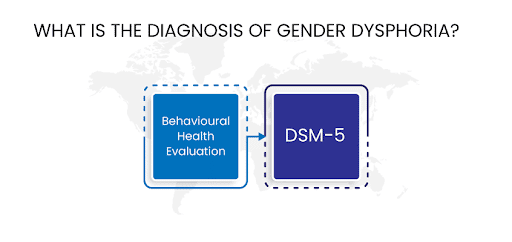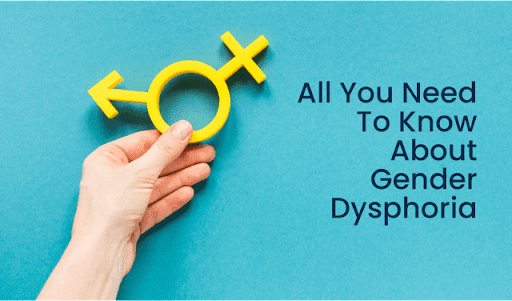Introduction
When there is incongruence between assigned sex and gender identity, the psychological distress that comes into play is called gender dysphoria. Simply put, it is a condition when an individual feels distressed when the gender they identify with and the gender assigned at birth does not match. This distress may take severe forms, including suicidal ideation. Fortunately, support from loved ones and medical professionals can make a difference. Learn more here.
What is Gender Dysphoria?
Gender dysphoria [1] is a condition where people do not feel a natural connection with their gender assigned at birth or the gender that society had ascribed to them at birth.
However, people with this issue may identify as the opposite sex to the assigned one at birth, or they may identify as somewhere in between genders (gender non-conforming), or they may not identify with any gender at all (agender or gender non-binary).
What are the causes of Gender Dysphoria?
There is no one answer to this question, as the causes of this problem are likely to be complex and varied. However, some factors that can contribute to gender dysphoria include:
- A difference in brain structure or hormones that leads to a feeling of being ‘trapped’ in the wrong body
- A history of trauma or abuse
- Social or cultural factors that lead to feelings of isolation or distress about one’s gender identity
It is important to remember that there is no ‘correct’ way to experience gender and that everyone’s journey is valid and unique. If you are struggling with this issue, it is essential to seek professional help and support. A therapist or counsellor can help you understand your feelings and plan how to cope best.
What are the Symptoms of Gender Dysphoria?
Some common symptoms of gender dysphoria in adults are:
- Wanting, or insisting, to be of the other gender
- A strong dislike of one’s sexual anatomy
- The desire to undergo surgery to modify one’s sexual anatomy to match one’s preferred gender
- A belief that one has the typical feelings and reactions of the other gender
- Cross-sex role preferences
- Desire to wear the clothes that are often associated with the opposite gender
In short, people dealing with gender dysphoria usually express that they want to be of another gender. They’re typically uncomfortable with their birth-assigned sex. It contributes to playing with toys that belong to the other gender or dressing up the way they like.
What is the diagnosis of Gender Dysphoria?
For the diagnosis of gender dysphoria [2], a medical healthcare professional performs a specific evaluation or test. These typically include:

Behavioural Health Evaluation
First of all, the medical healthcare professional will thoroughly analyse your situation to confirm if there are any symptoms of this issue. Once the doctor confirms the facts, he will relate how gender identity discrimination and prejudice impact your mental health. The doctor needs to understand further the support you get from your peers, family, relatives, etc.
DSM-5
The American Psychiatric Association published the Diagnostic and Statistical Manual of Mental Disorders (DSM-5) helps doctors analyse gender dysphoria. According to DSM-5, there are different criteria for this problem for children, adolescents and adults. Here we’ve compiled the diagnosis of gender dysphoria in children, adolescents and adults.
The diagnosis of Gender Dysphoria
For Adults and Adolescents
However, the indications for an adult or adolescent diagnosed with this issue include impairments or distress in work, social or other crucial life areas. So the feelings of hopelessness should last for more than six months with a few symptoms, such as:
- Firstly desire to get rid of primary or secondary characteristics of sex
- Urge to have primary or secondary attributes of sex of the opposite gender
- Incongruence between the experienced gender of the individual and his primary or secondary sex characteristics
- Urge to be their experienced gender and to be treated [3] as their experienced gender as well
- Feelings, behaviours, or reactions regarding having their experienced gender
Someone suffering from gender dysphoria must exhibit any two of the above symptoms.
For Children
For a child to be diagnosed with gender dysphoria, they must feel significant distress or functioning impairment for at least six months. Besides this, they must have any six symptoms from the list below.
- Desire or insistence on being of the opposite gender
- Preferring clothing that relates to the opposite gender
- Preferring engaging in opposite-gender roles in fantasy play
- Choose toys that relate to the opposite gender
- Rejecting the play or toys that relate to their birth-assigned gender
- Urge to have the sex characteristics that align with their gender identity
- Playing with children who belong to the opposite gender
- Dislike for their physical sex characteristics
- What are the interventions for a diagnosis of Gender Dysphoria?
Interventions for gender dysphoria usually involve a combination of psychological therapy, medical intervention, and social support.
- 1 Psychological therapy aims at helping the individual to explore their gender identity and come to terms with any associated issues or anxieties. The various interventions include individual therapy, group therapy, and family therapy.
- 2. Medical intervention may be necessary to transition to the desired gender physically, and it can involve hormone replacement therapy and surgery.
- 3. Social support is essential for individuals going through this issue, and it can come from family, friends, therapists, support groups, or the broader transgender community. If you think you may have gender dysphoria, you must see a mental health professional who can thoroughly evaluate and diagnose. Interventions for gender dysphoria can be very effective in reducing distress and improving functioning.
Conclusion
According to the article, we have answered some common questions – including symptoms and intervention options – about gender dysphoria, providing an overview of the condition. Remember, if you think you or someone you know may be struggling with this issue, it’s essential to seek professional help.
Contact United We Care’s experts if you want to improve your emotional or mental health. We’d love to help you with the best assistance to overcome the emotional barriers.
| [1] | Psychiatry.org. [Online]. Available: https://psychiatry.org/patients-families/gender-dysphoria/. [Accessed: 20-Dec-2022]. |
| [2] | The Royal Australian College of General Practitioners, “Gender dysphoria,” Australian Family Physician. [Online]. Available: https://www.racgp.org.au/afp/2015/november/gender-dysphoria. [Accessed: 20-Dec-2022]. |
| [3] | “Gender dysphoria,” Mayoclinic.org, 26-Feb-2022. [Online]. Available: https://www.mayoclinic.org/diseases-conditions/gender-dysphoria/diagnosis-treatment/drc-20475262. [Accessed: 20-Dec-2022]. |





